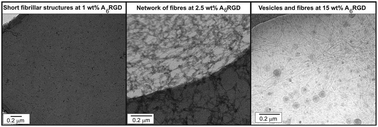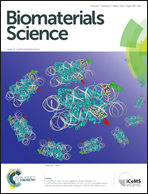Alanine-rich amphiphilic peptide containing the RGD cell adhesion motif: a coating material for human fibroblast attachment and culture†
Abstract
We studied the self-assembly of peptide A6RGD (A: alanine, R: arginine, G: glycine, D: aspartic acid) in water, and the use of A6RGD substrates as coatings to promote the attachment of human cornea stromal fibroblasts (hCSFs). The self-assembled motif of A6RGD was shown to depend on the peptide concentration in water, where both vesicle and fibril formation were observed. Oligomers were detected for 0.7 wt% A6RGD, which evolved into short peptide fibres at 1.0 wt% A6RGD, while a co-existence of vesicles and long peptide fibres was revealed for 2–15 wt% A6RGD. A6RGD vesicle walls were shown to have a multilayer structure built out of highly interdigitated A6 units, while A6RGD fibres were based on β-sheet assemblies. Changes in the self-assembly motif with concentration were reflected in the cell culture assay results. Films dried from 0.1–1.0 wt% A6RGD solutions allowed hCSFs to attach and significantly enhanced cell proliferation relative to the control. In contrast, films dried from 2.5 wt% A6RGD solutions were toxic to hCSFs.


 Please wait while we load your content...
Please wait while we load your content...